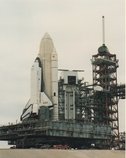STS-1
|
|
| Mission Insignia | |
|---|---|
| Missing image STS-1_flight_insignia.png image:STS-1 flight insignia.png | |
| Mission Statistics | |
| Mission: | STS-1 |
| Shuttle: | Columbia |
| Launch Pad: | 39A |
| Launch: | April 12, 1981 6:00:03 a.m. CST (12:00:03 UTC) |
| Landing: | April 14, 1981 12:20:57 p.m. CST (18:20:57 UTC) Edwards AFB, Runway 23 |
| Duration: | 2 days, 6 hours, 20 minutes, 53 seconds |
| Orbit Altitude: | 166 nautical miles (307 km) |
| Orbit Inclination: | 40.3 degrees |
| Orbits: | 36 |
| Distance Traveled: | 1,074,000 miles (1,728,000 km) |
| Crew photo | |
|
Missing image | |
The first Space Shuttle mission, STS-1, launched April 12, 1981, returned April 14. Space Shuttle Columbia orbited the earth 36 times in this 54.5 hour mission.
STS-1 is also an abbreviation for Synchronous Transport Signal (level)-1 in the SONET hierarchy.
| Contents |
Crew
- Commander: John W. Young (flew on Gemini 3, Gemini 10, Apollo 10, Apollo 16, STS-1, & STS-9)
- Pilot: Robert Crippen (flew on STS-1, STS-7, STS-41-C, & STS-41-G)
The crew of STS-2 served as backup for this mission.
- Backup Commander: Joe Engle
- Backup Pilot: Richard Truly
Mission parameters
- Mass:
- Orbiter Liftoff: 99,453 kg
- Orbiter Landing: 88,662 kg
- DFI payload: 4,909 kg
- Perigee: 240 km
- Apogee: 251 km
- Inclination: 40.3°
- Period: 89.4 min
Mission highlights
The first launch of the Space Shuttle occurred on April 12, 1981, when the orbiter Columbia, with two crew members, astronauts John W. Young, commander, and Robert L. Crippen, pilot, lifted off from Pad A, Launch Complex 39, at the Kennedy Space Center -- the first of 24 launches from Pad A. It was exactly 7 a.m. EST. A launch attempt, 2 days before, was scrubbed because of a timing problem in one of the Columbia's general purpose computers.
Not only was this the first launch of the Space Shuttle, but it marked the first time that solid fuel rockets were used for a U.S. manned launch. The STS-1 orbiter, Columbia, also holds the record for the amount of time spent in the Orbiter Processing Facility (OPF) before launch -- 610 days, time needed for replacement of many of its heat shield tiles.
Primary mission objectives of the maiden flight were to check out the overall Shuttle system, accomplish a safe ascent into orbit and to return to Earth for a safe landing. All of these objectives were met successfully and the Shuttle's worthiness as a space vehicle was verified.
The only payload carried on the mission was a Development Flight Instrumentation (DFI) package which contained sensors and measuring devices to record orbiter performance and the stresses that occurred during launch, ascent, orbital flight, descent and landing.
The 36-orbit, 933,757-mile-long flight lasted 2 days, 6 hours, 20 minutes and 32 seconds. Landing took place on Runway 23 at Edwards AFB, Calif., on April 14, 1981, at 10:21 a.m. PST. Post-flight inspection of the Columbia revealed that an overpressure wave which occurred when the SRB ignited resulted in the loss of 16 heat shield tiles and damage to 148 others. In all other respects, however, Columbia came through the flight with flying colors, and it was to fly the next four Shuttle missions.
Columbia was returned to Kennedy Space Center from California on April 28 atop its 747 carrier aircraft.
Mission insignia
The art work for the official mission insignia was done by artist Robert McCall.
Anniversary
Yuri's Night is an international celebration held on April 12 every year to commemorate the first human in space and the first Space Shuttle launch.
Media
Missing image
Columba.sts-1.training.triddle.jpg

 Missing image
Missing image
Columbia.sts-1.pad_at_night.triddle.jpg
 Missing image
Missing image
Sts1-liftoff-columbia.triddle.jpg
Missing image
Columbia_landing_on_Rogers_dry_lake.triddle.jpg
Missing image
Columbia.sts-1.egress.triddle.jpg
External links
- NASA PAO page about STS-1 (http://www-pao.ksc.nasa.gov/kscpao/chron/sts-1.htm)
| Previous Mission: Apollo-Soyuz |
Space Shuttle program | Next Mission: STS-2 |
